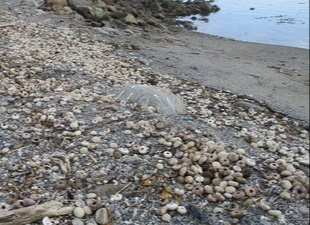Many sea urchins are seen washed up on a beach in Erimo, Hokkaido, on Sept. 27, 2021 in this photo provided by the Hidaka Subprefectural Bureau)
A large volume of sea urchins and salmon have recently been found dead in various parts of the northernmost Japan prefecture of Hokkaido apparently because of red tide, and the “catastrophic damage” has left people in the fishery industry confused and disappointed.
The Konbumori Fisheries Cooperative in the southeastern Hokkaido town of Kushiro conducted an underwater survey on short-spined sea urchins on Sept. 28, and confirmed that about 90% of the estimated population had died. Some 330 autumn salmon were also confirmed to have died by Sept. 29. The Akkeshi Fisheries Cooperative in the neighboring town of Akkeshi also found approximately 80% of its salmon had perished.
Toru Ihata, the executive managing director at the Konbumori Fisheries Cooperative, said, “This has never happened before.” A representative at the Akkeshi Fisheries Cooperative said, “If we include the catches that would have been made next year and the following year, the damage is catastrophic.”
The Erimo Fisheries Cooperative in the southern Hokkaido town of Erimo began to notice a massive amount of dead short-spined sea urchins had washed ashore and salmon that had perished in fixed fishing nets around Sept. 20. The cooperative’s Toyo district sea urchin division head Tsutomu Ikeda, 60, lamented, “The damage may be devastating. Our efforts to release young sea urchins for many years have gone to waste. I think the situation will be tough for several years to come.”
A similar phenomenon has also occurred on the Pacific Ocean coast of the Tokachi area, mainly at the fishing port of Otsu in the town of Toyokoro. According to the Otsu Fisheries Cooperative, dead salmon began to be caught in fixed nets around Sept. 22, and about 4,200 of them had been caught by Sept. 29.
The sea water on the coast began to become murky in mid-September, and a large amount of plankton, which causes red tide, was found.
(Japanese original by Hiroaki Homma, Nemuro Bureau; Kimitaka Hirayama, Tomakomai Bureau; and Hitoshi Suzuki, Obihiro Bureau)



